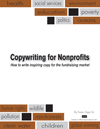 Today I share a collection of tips to make your fundraising appeals – direct mail or email – a whole lot more effective.
Today I share a collection of tips to make your fundraising appeals – direct mail or email – a whole lot more effective.
And in keeping with the spirit of the title, I’ll stick to the points and not pontificate:
• Speak (I mean out loud) what you want to write. Then write what you said; how you said it.
• Define the purpose of the appeal; the goal
• Write the P.S. first – your offer
• Don’t be a nit-pick grammarian. (Read the first bullet again)
• Lose the jargon
• It’s NOT about your nonprofit
• Hero of your mission is the donor or member. Make this clear in your copy.
• Have plenty of white space – yes, even in email
• Use a larger font, and one that’s easy to read
• Black (not gray) colored font on white background is the easiest to read; body of your copy ought to be black on white
• Short sentences. Short paragraphs.
• Letters should not look like a business letter. Indent paragraphs. Do not justify margins.
• Highlight key passages (bold; italics; or underlining depending on the channel)
• Write reader-centric copy
• Tell a great story – master this art
• Clear call-to-action
• Don’t ramble
• Use emotion, passion, and opinions
• Write for skimmers
• Employ direct response principles
• Use a warm, friendly tone
• Show how donors make a difference
Concepts seem simple; yet few can do them well. That’s your challenge.
Related posts:
Bore your nonprofit readers in 11 different ways

{ 3 trackbacks }
{ 2 comments… read them below or add one }
Love your comment to write the PS first! I’ve taken it a step further and written the thank you letter first :).
Hi Pamela,
Yes, the P.S. is quite important.
And to expand on the point . . . I write it first because the P.S. summarizes the entire letter. It is the longer version – if you will – of the reply device.
When the P.S. is clear, well-written, and infused with emotion . . . writing the email or the direct mail letter is easier (note that I said “easier” and not “easy). It gives direction to the letter / email and your writing has more focus and a clear purpose. The odds are that your first draft will be stronger and require less editing when the P.S. is written first, followed by the reply device, and then the lead (envelope teaser or email subject line falls in here too).
I find this approach the most successful.
And in contrast to your approach, I deliberately write the “thank you letter” LAST. (Smile)
Why? Because I want all the emotion from the letter or email expressed. I want to personally feel everything there is to feel before I acknowledge gratitude for the donor’s generosity and compassion. This approach results in a more personalized and emotional thank you letter. But again, that’s what works for me when writing fundraising copy.
Thanks for weighing in on the topic, Pamela!